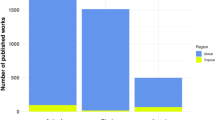Abstract
There is no single best index that can be used to answer all questions about species diversity. Entropy-based diversity indices, including Hill’s indices, cannot account for geographical and phylogenetic structure. While a single diversity index arises if we impose several constraints—most notably that gamma diversity be completely decomposed into alpha and beta diversity—there are many ecological questions regarding species diversity for which it is counterproductive, requiring decomposability. Non-decomposable components of gamma diversity may quantify important intrinsic ecological properties, such as resilience or nestedness.
Similar content being viewed by others
References
Banach S, Tarski A (1924) Sur la décomposition des ensembles de points en parties respectivement congruentes. Fund Math 6:244–277
Bascompte J, Jordano P, Melián CJ, Olesen JM (2003) The nested assembly of plant-animal mutualistic networks. Proc Natl Acad Sci USA 100:9383–9387
Bedeian AG, Mossholder KW (2000) On the use of the coefficient of variation as a measure of diversity. Organ Res Method 3:285–297
Boltzmann L (1872) Weitere studien über das wärmegleichgewicht unter gasmolekülen. Sitzungsber Akad Wiss Wein 66:275–370
Cachelin A, Norvell R, Darling A (2010) Language fouls in teaching ecology: why traditional metaphors undermine conservation literacy. Conserv Biol 24:669–674
Daily GC (ed) (1997) Nature’s services: societal dependence on natural ecosystems. Island Press, Washington, DC
Felsenstein J (1985) Phylogenies and the comparative method. Am Nat 125:1–15
Feyerabend P (1975) Against method: outline of an anarchistic theory of knowledge. New Left Books, London
Garland T, Harvey PH, Ives AR (1992) Procedures for the analysis of comparative data using phylogenetically independent contrasts. Syst Biol 41:18–32
Gorelick R, Bertram SM (2007) Quantifying division of labor: borrowing tools from sociology, sociobiology, information theory, landscape ecology, and biogeography. Insect Soc 54:105–112
Gorelick R, Bertram SM (2010) Multi-way multi-group segregation and diversity indices. PLoS One 5:e10912 (online)
Grusky DB, Charles M (1998) The past, present, and future of sex segregation methodology. Demography 35:497–504
Hill MO (1973) Diversity and evenness: unifying notation and its consequences. Ecology 54:427–432
Hoffmann S, Hoffmann A (2008) Is there “true” diversity? Ecol Econ 65:203–205
Holling CS (2001) Understanding the complexity of economic, ecological, and social systems. Ecosystems 4:390–405
Jost L (2006) Entropy and diversity. Oikos 113:363–375
Lakoff G, Johnson M (1980) Metaphors we live by. University of Chicago Press, Chicago
Lobachevski N (1840) Geometrical researches on the theory of parallels [translator: G. B. Halstead, 1914]. Open Court, La Salle
Martin WT, Gray LN (1971) Measurement of relative variance: sociological examples. Am Soc Rev 36:496–502
Martins EP, Hansen TF (1997) Phylogenies and the comparative method: a general approach to incorporating phylogenetic information into the analysis of interspecific data. Am Nat 149:646–667
Mendes RS, Evangelista LR, Thomaz SM, Agostinho AA, Gomes LC (2008) A unified index to measure ecological diversity and species rarity. Ecography 31:450–456
Moreno CE, Rodríguez P (2011) Do we have a consistent terminology for species diversity? Back to basics and toward a unifying framework. Oecologia. doi:10.1007/s00442-011-2125-7
Norton BG (1994) On what we should save: the role of cultures in determining conservation targets. In: Forey P, Humphries CJ, Vane-Wright RI (eds) Systematics and conservation evaluation. Systematics Association/Clarendon Press, Oxford, pp 23–40
Rao CR (1982) Diversity and dissimilarity coefficients: a unified approach. Theor Popul Biol 21:24–43
Reardon SF, Firebaugh G (2002) Measures of multigroup segregation. Soc Method 32:33–67
Shannon CE (1948) A mathematical theory of communication. Bell Sys Tech J 27:379–423, 623–656
Strang G (1976) Linear algebra and its applications. Academic, New York
Tilman D, Wedin D, Knops J (1996) Productivity and sustainability influenced by biodiversity in grassland ecosystems. Nature 379:718–720
Tufte ER (1983) The visual display of quantitative information. Graphics Press, Cheshire
Tuomisto H (2010) A consistent terminology for quantifying species diversity? Yes, it does exist. Oecologia 164:853–860
Wagner GP (2010) The measurement theory of fitness. Evolution 64:1358–1376
Wagner GP, Laubichler MD, Bagheri-Chaichian H (1998) Genetic measurement theory of epistatic effects. Genetica 102(103):569–580
Walker B (2001) Ecosystems and immune systems: useful analogy or stretching a metaphor? Conserv Ecol 15:16 (online)
Walker B, Holling CS, Carpenter SR, Kinzig A (2004) Resilience, adaptability and transformability in social-ecological systems. Ecol Soc 9:5 (online)
Williams KY, O’Reilly CA (1998) Demography and diversity in organizations: a review of 40 years of research. In: Staw BM, Cummings LL (eds) Research in organizational behavior, vol 20. JAI Press, Greenwich, CT, pp 77–140
Acknowledgments
Thanks to the Natural Sciences and Engineering Research Council of Canada (NSERC), with whom I have no conflict of interest, for a Discovery Grant. Thanks to Hanna Tuomisto and an anonymous reviewer for many helpful comments.
Author information
Authors and Affiliations
Corresponding author
Additional information
Communicated by Scott Collins.
Rights and permissions
About this article
Cite this article
Gorelick, R. Commentary: Do we have a consistent terminology for species diversity? The fallacy of true diversity. Oecologia 167, 885–888 (2011). https://doi.org/10.1007/s00442-011-2124-8
Received:
Accepted:
Published:
Issue Date:
DOI: https://doi.org/10.1007/s00442-011-2124-8




